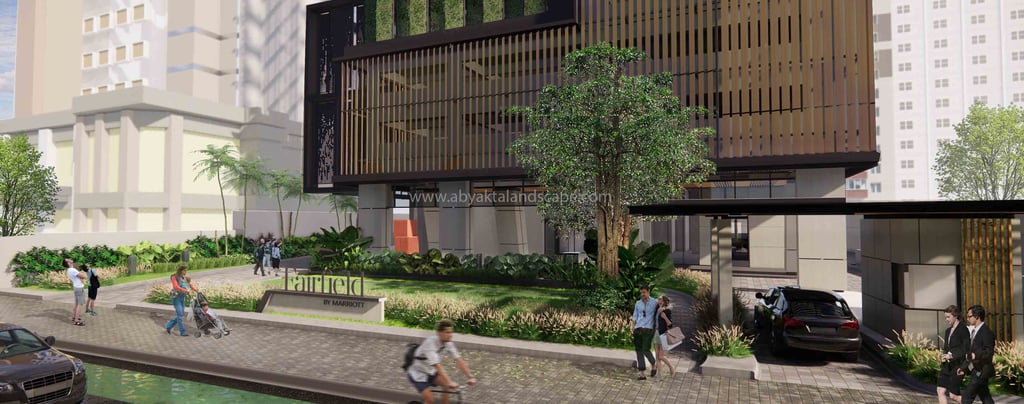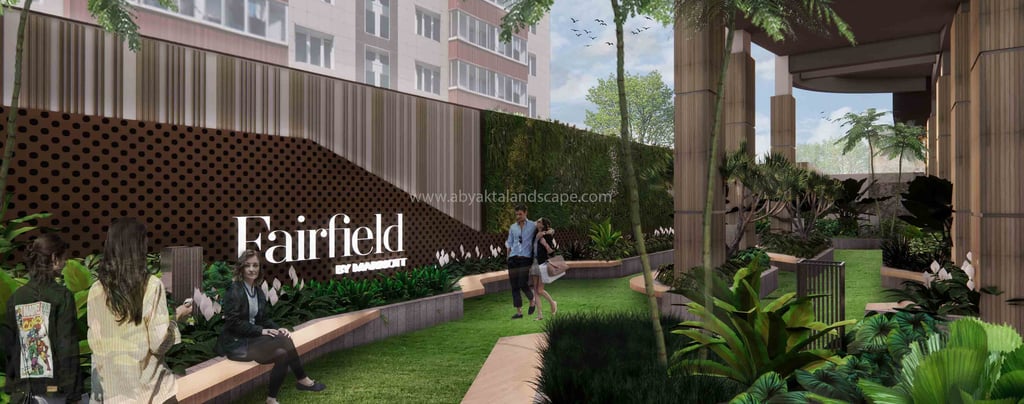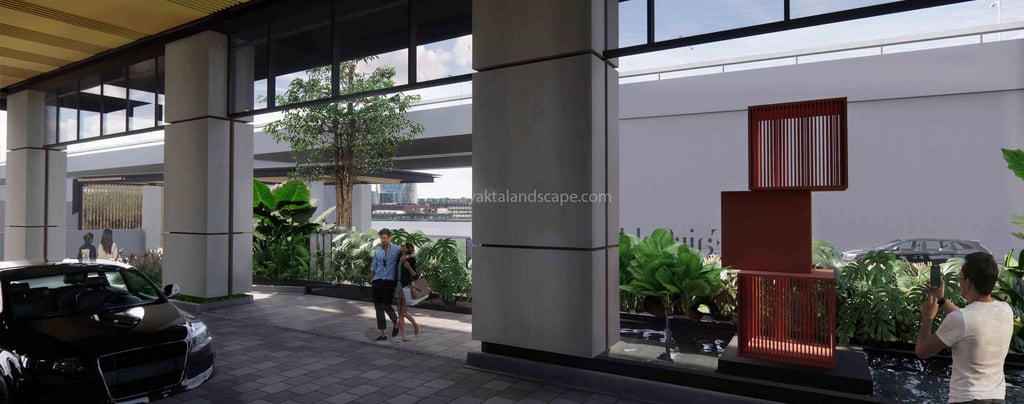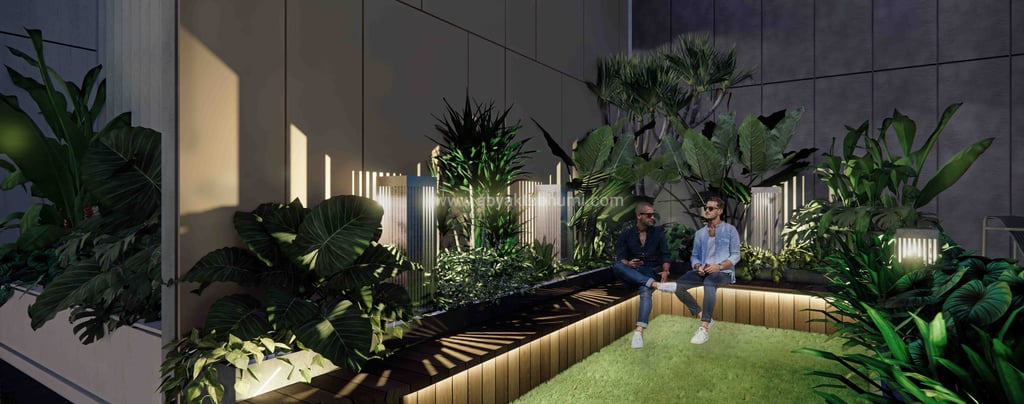Modern Contemporary Design: Fairfield Hotel by Marriott
To harmonize modern contemporary design of the building, in this project we transforms the spaces into a harmonious blend of sophistication and tranquility with contemporary lush approach. Each element is thoughtfully positioned to enhance both aesthetics and functionality. The palette of neutral tones creates a canvas for the interplay of light and shadow, bringing a sense of calm and balance to the surroundings.
Abyakta Landscape
8/9/20245 min read

Transforming Spaces with Modern Contemporary Design
Modern contemporary design is characterized by its emphasis on simplicity, clean lines, and a seamless blend of aesthetics and functionality. At its core, this design philosophy aims to create spaces that are visually striking yet soothing, where every element is meticulously positioned to enhance the overall experience. The transformation of spaces into harmonious environments involves several key considerations:
1. Neutral Tones as a Canvas: The palette of neutral tones—such as whites, greys, and earth tones—serves as a foundational element in modern contemporary design. These colors provide a versatile backdrop that allows other design elements to stand out while maintaining a cohesive look. Neutral tones create a serene environment, providing a canvas for the interplay of light and shadow, which contributes to the overall sense of calm and balance.
2. Thoughtful Spatial Arrangement: In modern contemporary design, the arrangement of space is critical. Each element, from furniture to architectural features, is positioned with precision to enhance both aesthetics and functionality. This thoughtful arrangement ensures that the space is not only visually pleasing but also practical and comfortable for its intended use.
Functionality and Sustainability
Functionality is a cornerstone of modern contemporary landscape design. Outdoor spaces are thoughtfully organized to cater to a variety of activities, ensuring that each area serves a specific purpose:
1. Entertainment Areas: Sleek entertainment areas are designed to facilitate gatherings and social events. These spaces may include outdoor kitchens, dining areas, and comfortable seating arrangements. The design emphasizes ease of use and accessibility, with features such as built-in grills, ample seating, and convenient lighting.
2. Lounging Spots: Cozy lounging spots provide areas for relaxation and contemplation. These spaces are often equipped with plush seating, ambient lighting, and calming elements such as water features or fire pits. The design focuses on creating a comfortable and inviting atmosphere where individuals can unwind and enjoy the outdoors.
3. Sustainable Practices: Modern contemporary landscape design places a strong emphasis on sustainability. This includes the integration of energy-efficient lighting, water-saving irrigation systems, and environmentally conscious plant selections. Sustainable practices not only contribute to the overall health of the environment but also enhance the long-term viability of the landscape.
The Role of Lighting
Lighting is a crucial element in modern contemporary design, offering both practical illumination and aesthetic enhancement. The strategic placement of lighting fixtures can dramatically alter the ambiance of a space, especially as day transitions into night:
1. Practical Illumination: Lighting serves a functional purpose, ensuring that outdoor spaces are safe and usable after dark. Pathway lights, step lights, and accent lights provide necessary illumination, making it easy to navigate the space and enjoy its features.
2. Dramatic Flair: Beyond functionality, lighting adds a dramatic flair to the landscape. The use of strategically placed fixtures can highlight architectural elements, accentuate focal points, and create a warm, inviting glow. The interplay of light and shadow enhances the visual appeal of the space, transforming the landscape into a dynamic and engaging environment.
3. Ambient Lighting: Ambient lighting contributes to the overall atmosphere of the space. Soft, diffuse lighting creates a calming effect, while the careful use of color temperature and light intensity adds depth and warmth. The goal is to create a harmonious balance between illumination and ambiance, enhancing the sensory experience of the landscape.
Integrating Principles
To fully realize the potential of modern contemporary design, it is essential to integrate its principles into both architectural and landscape elements. This involves a cohesive approach that considers the following aspects:
1. Seamless Transition: The transition between indoor and outdoor spaces should be seamless, with design elements that flow naturally from one area to the next. This may include the use of similar materials, colors, and design motifs to create a unified aesthetic.
2. Balance and Proportion: Achieving balance and proportion is key to modern contemporary design. This involves the careful arrangement of elements to create a sense of harmony and coherence. Proportional relationships between different components, such as furniture, architectural features, and landscaping elements, contribute to the overall visual appeal.
3. Personalization: While modern contemporary design emphasizes simplicity and minimalism, there is room for personalization and individuality. Incorporating unique design elements, personal touches, and custom features allows for a space that reflects the personality and preferences of its occupants.
4. Adaptability: Modern contemporary design should be adaptable to changing needs and preferences. This may involve flexible furniture arrangements, modular design elements, and adaptable outdoor spaces that can be easily reconfigured to suit different activities and events.
The integration of modern contemporary design principles into both architectural and landscape elements creates spaces that are characterized by sophistication, tranquility, and functionality. By employing a neutral color palette, utilizing minimalist hardscape materials, and incorporating thoughtfully designed elements such as water features and curated plant selections, modern contemporary design achieves a harmonious balance between aesthetics and practicality.
Functionality and sustainability are integral to this design approach, with outdoor spaces organized to cater to various activities while incorporating eco-friendly practices. Lighting plays a crucial role in enhancing the ambiance of the space, adding both practical illumination and dramatic flair.
Ultimately, the goal of modern contemporary design is to create environments that are visually striking yet serene, offering a refined and harmonious experience for occupants. By thoughtfully integrating design principles and considering the diverse needs of users, modern contemporary design transforms spaces into sophisticated, tranquil retreats that reflect both elegance and functionality.
Key Features
Modern contemporary landscape design extends the principles of interior design into outdoor spaces, creating environments that are both visually appealing and highly functional. Several key features define this approach:
1. Minimalist Hardscape Materials: A hallmark of modern contemporary landscape design is the use of minimalist hardscape materials such as concrete, steel, glass, and composite materials. These materials contribute to a sense of sophistication and visual continuity. Concrete and steel offer clean lines and a modern aesthetic, while glass and composite materials add a touch of elegance and contemporary flair. The combination of these materials creates outdoor spaces that are striking in their simplicity and effectiveness.
2. Architectural Elements: Stylish furniture and distinctive focal points are integral to modern contemporary landscapes. These elements not only enhance the aesthetic appeal of the space but also provide functional areas for relaxation, socializing, and contemplation. Furniture pieces are often chosen for their sleek design and comfort, while focal points such as sculptures or modern fire pits add character and visual interest.
3. Water Features: Elegantly integrated water features play a significant role in modern contemporary landscapes. These features introduce dynamic elements that engage the senses and enhance the overall appeal of the space. Water features, such as reflecting pools, cascading waterfalls, or minimalist fountains, contribute to the sensory experience of the landscape, providing both visual and auditory stimulation.
4. Plant Palette: The selection of plants in contemporary landscapes is carefully curated to achieve a harmonious balance. This often involves combining native vegetation with sculptural plants to create visual interest and support the overall design theme. Native plants are chosen for their adaptability and low maintenance requirements, while sculptural plants add unique shapes and textures to the landscape.








Harmonizing Modern Contemporary Design with Tranquility: A Comprehensive Exploration
In the realm of architecture and landscape design, the pursuit of a harmonious blend of sophistication and tranquility is a central theme in modern contemporary design. This approach seeks to create spaces that not only captivate the eye but also foster a sense of calm and balance. The integration of contemporary elements with a lush, tranquil approach offers a refined aesthetic that enhances both the visual appeal and functionality of a space. This comprehensive exploration delves into the intricacies of modern contemporary design, examining how thoughtful spatial arrangement, material selection, and design elements contribute to a sophisticated yet serene environment.
ABYAKTA
PT Abyakta Bhumi Arya, established in 2019, is a landscape company based in Bogor, Indonesia. We are composed of licensed and experienced landscape team who are dedicated to both landscape design and construction. This dedication makes us a reliable partner for your landscape project. We collaborate closely with clients to understand their needs, preferences, and the unique characteristics of each site. This approach allows us to develop custom landscape designs that meet your specific goals.
CONTACT US
© 2019-2025 Abyakta Landscape. All Rights Reserved.
